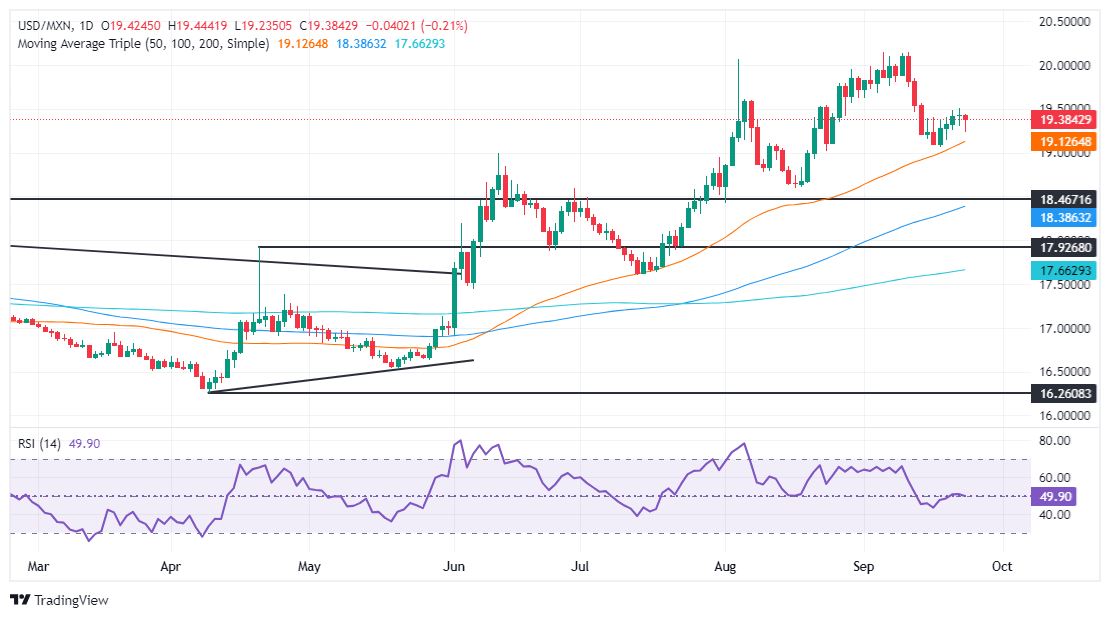Mexican Peso rises as US consumer turns pessimistic, Banxico cut eyed
- Mexican Peso strengthens after US Consumer Confidence deteriorated.
- Mexico’s inflation fell below estimates in September, with core inflation easing under 5%, boosting expectations for a 25 bps rate cut by Banxico on Thursday.
- Analysts expect Banxico to lower rates from 10.75% to 10.50%, citing falling inflation, weaker economic activity and Fed easing.
The Mexican Peso advanced against the US Dollar during the North American session after the Conference Board (CB) revealed that Consumer Confidence in the United States (US) deteriorated. Meanwhile, Mexican inflation dipped below estimates ahead of Thursday's Bank of Mexico (Banxico) monetary policy meeting. At the time of writing, the USD/MXN trades at 19.36, dropping over 0.28%.
Mexico’s inflation in the first half of September dipped in MoM and YoY figures, according to the Instituto Nacional de Estadistica Geografia e Informatica (INEGI). Core numbers edged lower after being above the 5% threshold and improved compared to the previous reading.
According to Reuters, Banxico is expected to lower interest rates by 25 basis points (bps) on September 26 from 10.75% to 10.50%.
Analysts at Capital Economics quoted by Reuters noted “The fall in inflation, combined with the weakness of economic activity and the fact that the US Fed is now easing monetary policy too, means that Banxico is all but certain to deliver another 25-basis-point cut.”.
Across the border, Consumer Confidence deteriorated in September, hitting its lowest level since August 2021 due to worries about the labor market and the broad economic outlook.
Meanwhile, Fed Governor Michelle Bowman said that risks to inflation are still prominent, adding that she favors “a measured pace of cuts” to avoid reigniting inflation.
Daily digest market movers: Mexican Peso on the front foot as inflation dips
- Mid-month inflation in September came to 0.09% MoM, below estimates of 0.15%. In the 12 months to September, it expanded by 4.66%, below forecasts of 4.73% and the previous reading of 5.16%.
- Underlying inflation for the same period increased slightly from 0.1% to 0.21% MoM, but it was beneath forecasts of 0.23%. Yearly, core prices dropped from 3.98% to 3.95%, lower than the consensus.
- Mexico’s Economic Activity expanded in July, while Retail Sales contracted for the third straight month but improved compared to June’s reading.
- Banxico is expected to lower borrowing costs by 175 bps toward the end of 2025, according to the swaps markets.
- CB Consumer Confidence in September dropped from 105.6 to 98.7, missing the 103.8 estimated by analysts.
- Dana Peterson, chief economist at the Conference Board, said, “The deterioration across the Index’s main components likely reflected consumers concerns about the labor market and reactions to fewer hours, slower payroll increases, fewer job openings.”
- Market participants had fully priced in a 100% chance of a 25 bps rate cut by the Fed. However, the odds for a 50 bps of easing are 56.2%, according to the CME FedWatch Tool date.
USD/MXN technical analysis: Mexican Peso recovers some ground as USD/MXN falls below 19.40
The USD/MXN remains intact despite consolidating at around the 19.00-19.50 range for the seventh consecutive day. Investors seem to be waiting for Banxico’s decision, though an “ascending wedge” is forming, implying further downside.
The Relative Strength Index (RSI) suggests that sellers gather momentum as the RSI punches below its neutral line. Therefore, the path of least resistance is skewed to the downside.
If USD/MXN tumbles below the September 23 low of 19.29, it will expose the confluence of the 50-day Simple Moving Average (SMA) and the September 18 low near 19.08 to 19.06.
Conversely, if the USD/MXN remains above 19.30, the next resistance will be 19.50, followed by the August 6 high at 19.61. Once cleared, the 20.00 level will follow, followed by the year-to-date (YTD) peak at 20.22.

Mexican Peso FAQs
The Mexican Peso (MXN) is the most traded currency among its Latin American peers. Its value is broadly determined by the performance of the Mexican economy, the country’s central bank’s policy, the amount of foreign investment in the country and even the levels of remittances sent by Mexicans who live abroad, particularly in the United States. Geopolitical trends can also move MXN: for example, the process of nearshoring – or the decision by some firms to relocate manufacturing capacity and supply chains closer to their home countries – is also seen as a catalyst for the Mexican currency as the country is considered a key manufacturing hub in the American continent. Another catalyst for MXN is Oil prices as Mexico is a key exporter of the commodity.
The main objective of Mexico’s central bank, also known as Banxico, is to maintain inflation at low and stable levels (at or close to its target of 3%, the midpoint in a tolerance band of between 2% and 4%). To this end, the bank sets an appropriate level of interest rates. When inflation is too high, Banxico will attempt to tame it by raising interest rates, making it more expensive for households and businesses to borrow money, thus cooling demand and the overall economy. Higher interest rates are generally positive for the Mexican Peso (MXN) as they lead to higher yields, making the country a more attractive place for investors. On the contrary, lower interest rates tend to weaken MXN.
Macroeconomic data releases are key to assess the state of the economy and can have an impact on the Mexican Peso (MXN) valuation. A strong Mexican economy, based on high economic growth, low unemployment and high confidence is good for MXN. Not only does it attract more foreign investment but it may encourage the Bank of Mexico (Banxico) to increase interest rates, particularly if this strength comes together with elevated inflation. However, if economic data is weak, MXN is likely to depreciate.
As an emerging-market currency, the Mexican Peso (MXN) tends to strive during risk-on periods, or when investors perceive that broader market risks are low and thus are eager to engage with investments that carry a higher risk. Conversely, MXN tends to weaken at times of market turbulence or economic uncertainty as investors tend to sell higher-risk assets and flee to the more-stable safe havens.

